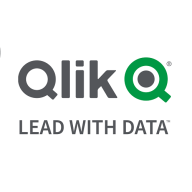

QlikView and Tableau Enterprise are two leading business intelligence tools that compete in the analytics category. While both offer distinct advantages, Tableau holds an upper hand with its vibrant visual data analysis features and extensive data connectivity options.
Features: QlikView leverages its unique AQL technology for flexible in-memory data processing, enabling dynamic interactions with large datasets. It excels with its built-in ETL engine, allowing seamless data manipulation and preparation. Additionally, its associative data model is powerful for non-linear data exploration. Tableau, known for its intuitive drag-and-drop interface, provides a vast array of visualization options, making it a preferred choice for visually compelling data analysis. It supports a broad range of data sources and offers interactive dashboards for dynamic data insights.
Room for Improvement: QlikView faces challenges with scalability due to its reliance on RAM, and its setup requires significant technical expertise, which can be a barrier to entry. Enhancing its adaptive scalability and user-friendliness could improve its competitive position. Tableau, while offering stunning visualizations, lacks full-fledged ETL capabilities, limiting data preparation options. Improvements in real-time data handling and the addition of more robust predictive modeling features could enhance its appeal.
Ease of Deployment and Customer Service: QlikView, often installed on-premises, requires considerable IT involvement for deployments, but benefits from a strong community support system. Despite its need for technical know-how, it remains a solid choice for businesses with in-house expertise. Tableau offers more flexibility, with both on-premises and cloud deployment options, facilitating easier setup and maintenance. Its robust community support aids problem-solving, although customer service quality might differ regionally.
Pricing and ROI: Both QlikView and Tableau come with high costs that mirror their advanced capabilities. QlikView's pricing is typically rigid, with costly licensing that can restrict scalability. On the other hand, Tableau presents more competitive pricing models but is often perceived as expensive for larger deployments. Successful implementation can lead to significant ROI for both products by enhancing data-driven decision-making processes; however, careful consideration of pricing structures and deployment strategies is crucial for maximizing returns.
The biggest return on investment is the time saving for the customer.
This saves a significant amount of time, particularly for reports that would have needed around fifty people.
The ROI of using Tableau extends to its seamless integration across various platforms, as it's from Salesforce and thus not limited to any specific cloud provider.
Tableau is saving me time, money, and resources, which I would rate as ten.
I would rate the customer support a solid 10.
They provide quick email and phone responses and have Thai-speaking personnel.
There should be consistent standards for all users.
The technical support for Tableau is quite good.
Tableau is easy to use across various dimensions, whether on-premises or on the cloud.
The solution is fully scalable and performs well even with large datasets, provided there is proper supporting hardware.
Tableau is easy to scale.
The application hangs after continuous use due to the buildup of cache.
I rate the stability a five or six because Tableau updates very often with new versions or patches.
In QlikView, I believe the improvement that should be made is to bring the costs down, as you'll have to be competitive with Power BI, aiming for at least a 30% reduction to stop the hemorrhaging to Power BI.
We cannot send the entire Excel file reports via email within Tableau.
The product owner should enhance its benefits or clarify its role.
It sometimes requires extensive investigation to determine why the data does not appear correctly.
The license cost per user or per year for QlikView is about 500 Euros annually.
Power BI as a much cheaper alternative.
A license for 150 users costs around $17,000 USD per year.
Looker is known to be quite expensive.
The best features in QlikView are rapid development, the fact that I can do what I want in QlikView, and full control along with ease of use.
A significant feature for me is the real-time connection to data sources because it effectively manages large data sets.
Tableau serves as a stable dashboarding tool for higher management, aiding in quick decision-making.
Building hyper extracts and visualization capabilities make Tableau a robust tool for data analysis.
| Product | Market Share (%) |
|---|---|
| Tableau Enterprise | 20.2% |
| QlikView | 4.7% |
| Other | 75.1% |


| Company Size | Count |
|---|---|
| Small Business | 73 |
| Midsize Enterprise | 36 |
| Large Enterprise | 75 |
| Company Size | Count |
|---|---|
| Small Business | 117 |
| Midsize Enterprise | 66 |
| Large Enterprise | 182 |
QlikView is a Business Intelligence tool that allows you to keep tabs on all of your business-related information in a clean, clear, and easy to access database that is intuitive to build and simple to navigate. It is ideal for business owners who wish to improve overall output by creating the most productive system possible.
Tableau Enterprise offers powerful features for creating interactive visualizations, dashboards, and maps, including drag-and-drop functionality and easy integration with multiple data sources, promoting real-time collaboration and self-service analysis.
Tableau Enterprise stands out with its ability to create user-friendly, interactive visualizations, making it pivotal for business intelligence applications. Users benefit from its seamless connectivity and advanced analytical functions, facilitating data blending and storytelling. Despite a complex learning curve and high licensing costs, its features like geospatial analysis and efficient content distribution drive its indispensable value for data-driven insights. Enhancements in predictive analytics and support integration with machine learning tools further its capabilities across industries.
What are the most valuable features?Tableau Enterprise is widely used for business intelligence, supporting industries like healthcare, telecommunications, and finance. Organizations utilize it to analyze performance indicators, operational insights, and financial analytics, enhancing decision-making through interactive reports and real-time data integration.
We monitor all Reporting reviews to prevent fraudulent reviews and keep review quality high. We do not post reviews by company employees or direct competitors. We validate each review for authenticity via cross-reference with LinkedIn, and personal follow-up with the reviewer when necessary.